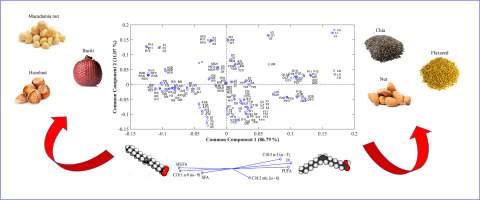Journal of Chromatography B ( IF 3 ) Pub Date : 2018-02-26 , DOI: 10.1016/j.jchromb.2018.02.031 Valéria Rampazzo , Leomara Floriano Ribeiro , Poliana Macedo Santos , Maresa Custódio Molinari Ferreira , Evandro Bona , Giselle Maria Maciel , Charles Windson Isidoro Haminiuk

|
The effect of heating in twenty-four different oil samples was evaluated via iodine value (IV), gas chromatography (GC) and mid-infrared (MIR) analyses. Common components and specific weights analysis (CCSWA) was applied to distribute the samples according to their most relevant characteristics, thereby revealing the influence of heating on composition. Instrumental analysis indicated a high amount of beneficial fatty acids, such as alpha-linolenic acid, in less exploited oils such as chia oil. This oil can present nutritional damage when subjected to high temperatures and is thus less recommended for frying. Conversely, oils containing high amounts of linoleic acid, such as almond and nut oils, as well as those containing equivalent amounts of alpha-linolenic and linoleic acids, such as golden flaxseed and flaxseed oils, displayed greater resistance to temperature. The 3008/cm band exhibited greater intensity in oils with a higher degree of unsaturation, such as chia and linseed oils, a phenomenon mainly influenced by the presence of linoleic and alpha-linolenic fatty acids. After heating, there was a decrease in the intensity of this band. The main parameter discriminating the tested oil samples based on CCSWA was the degree of unsaturation. Overall, the employed statistical method was effective in analyzing the data obtained via the applied techniques, revealing the influence of each assessed parameter.
中文翻译:

多块分析与GC-FID和ATR-MIR结合使用,可评估植物油中的热降解
通过碘值(IV),气相色谱(GC)和中红外(MIR)分析评估了二十四个不同油样品中的加热效果。应用通用成分和比重分析(CCSWA)根据样品的最相关特征对其进行分配,从而揭示出加热对成分的影响。仪器分析表明,在较少利用的油(例如,奇亚油)中存在大量的有益脂肪酸(例如,α-亚麻酸)。这种油在高温下会损害营养,因此不建议用于油炸。相反,含有大量亚油酸的油,例如杏仁油和坚果油,以及含有等量的α-亚麻酸和亚油酸的油,例如金色亚麻籽和亚麻籽油,显示出更高的耐温性。3008 / cm带在具有较高不饱和度的油(例如,奇亚和亚麻籽油)中表现出更高的强度,这种现象主要受亚油酸和α-亚麻酸脂肪酸的存在影响。加热后,该带的强度降低。基于CCSWA区分测试油样的主要参数是不饱和度。总体而言,采用的统计方法可以有效地分析通过应用技术获得的数据,从而揭示每个评估参数的影响。这个频段的强度降低了。基于CCSWA区分测试油样的主要参数是不饱和度。总体而言,采用的统计方法可以有效地分析通过应用技术获得的数据,从而揭示每个评估参数的影响。这个频段的强度降低了。基于CCSWA区分测试油样的主要参数是不饱和度。总体而言,采用的统计方法可以有效地分析通过应用技术获得的数据,从而揭示每个评估参数的影响。



























 京公网安备 11010802027423号
京公网安备 11010802027423号